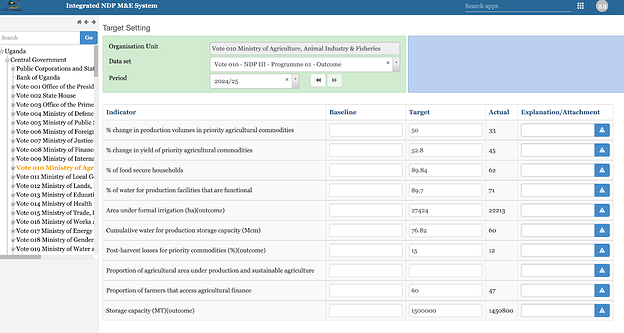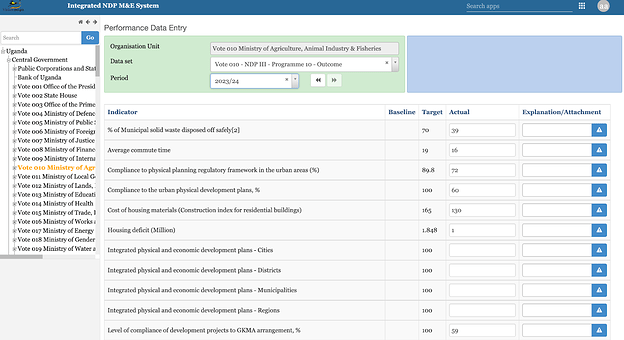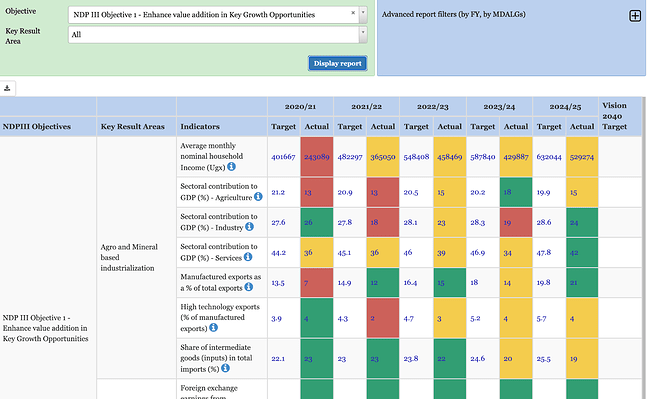By @Eric_Munyambabazi , @omielp and @prosper
Background
Uganda’s 3rd National Development Plan (NDP III) is a 5 years plan (2020-2025) that uses a programme-based approach to planning, budgeting, implementation and results reporting. This plan has 20 National Programmes, each of them sub-divided into sub-programmes, objectives, interventions, sub-interventions, outputs and actions that make the M&E results chain with over 5,000 indicators and data points along this hierarchy broadly considered as outcome and output level indicators.
For this NDP III, the government developed Programme Implementation Action Plans (PIAPs) that specify the outcomes, outputs, activities and resources required to deliver the programme targets and each of these targets have been assigned to Ministry, Department and Agency (MDA) who is responsible for implementation and reporting of the results.
In collaboration with partners, the government of Uganda through its agencies developed the NDP III Web-based M&E system on the DHIS2 platform to support the implementation of this plan by enabling MDAs to capture targets and actual results and be able to analyze their performance against set targets. This system is being developed and implemented jointly with HISP Ethiopia and HISP Uganda, with the initial development work done by HISP Ethiopia.
This particular DHIS2 use case not only goes beyond Health but expands the use of DHIS2 in all Ministries, Government Departments and Agencies in Uganda.
Key features of the system
This system is current built on DHIS2 Version 2.34 and in order to meet the requirements of the plan and to be able to enable users to capture and analyze data based on this M&E results framework, 4 main custom DHIS2 web apps have been developed;
- Custom NDP Landing page app - As shown in the figure 1, this app enables users to navigate through the performance across the different levels of results and be able to generate the performance matrix shown in figure 4 for each of this level. It also provides for period and organisational units filters that can enable users to generate performance for a desired MDA, programme or intervention for a given period.
- Making this use-case more generic, configurable for use in the general M&E results monitoring.
Figure 1: Landing page
- Custom NDP Target setting app - As shown in figure 2, this enables users to enter targets and baseline values for their respective MDAs and for each target value captured there is a provision to attach or add explanation of the targets.
Figure 2: Target setting app
- Custom NDP Performance data Entry app - As shown in figure 3, this enables users to enter actual performance values for their respective MDAs and for each performance value captured there is a provision to attach or add explanation of the performance.
Figure 3: Performance Data Entry App
- Custom NDP Document Library - This enables sharing of the documents related to the NDP III and the system. Users can upload and catelogue documents in the system for the other to be able to access and download
Figure 4: Performance Matrix
Implementation Methods
The development and implementation is coordinated by the Office of the Prime Minister (OPM) with technical support of National Planning Authority (NPA) who is responsible for national planning and has been at the forefront of indicator development and target setting. Using the 3rd National Development Plan 2020/21 – 2024/25 ( http://www.npa.go.ug/wp-content/uploads/2020/08/NDPIII-Finale_Compressed.pdf), and other resource materials, requirements were gathered and documented and used to develop 6 fully customized DHIS2 apps ( NDP Landing Page, NDP Targets Settings, NDP Target data entry, NDP Performance Date Entry, NDP Results Tracking, NDP Document Library) in addition to existing modules. In the development of process, reviews and demonstrations were conducted to stakeholders and this generated feedback that has enabled the system to go through several iterations of the development. Todate , the data capture modules are fully developed and ready for data entry and hence the reason training of end users were conducted to kick start this phase of implementation.
Accomplishments
Among key success factors mentioned government by-in and full ownership including hosting of the system by the government National Information and technology Authority (NITA U), the success recorded by other Ministries like Ministry of Health (MoH), Ministry of Education (MoE) in implementing the DHIS2 platform and fully digitizing service provision to the population. Availability of local Technical Assistance (TA) through the HISP groups and the flexibility of the DHIS2 platform to generate user-friendly visualizations. 100% (151 government MDAs) are fully capacitated to access and provide timely reports and analysis.
Official Launch and commissioning by Prime Minister :- Launched on 16th June 2021 by the Honorable Prime Minister, the NDPIII M&E System, has been fully adopted by the government of Uganda and is currently supervised by the Office of the Prime Minister, with technical support from the National Planning Authority (NPA), HISP Uganda and HISP Ethiopia. To foster linkages, the system has been integrated Other government systems, including the Integrated Bank of Projects (IBP) at the Ministry of Finance, Planning and Economic Development (MoFPED) to harmonize project monitoring and performance reporting. Also projected to link to other government systems including the PBS, and IFMIS.
Hosting and migration to the National Data Center : - With coordination from the OPM, the system was quickly adopted and moved to National data Centers at the National Information and Technology Authority of Uganda (NITA-U). At NITA-U, 3 server instances were provided to facilitate hosting of the system beginning with the provision of government domain (go.ug). The 3 instances include;
- The production server instance
- The development server instance
- The training server instance
The instances have been very instrumental in the development process, feedback generation and implementation and subsequently facilitating capacity building for the national teams. While hosted at the National data centers, the national team assures security and infrastructure availability for the utmost performance of the system.
Documentation of materials and Guides :- System documentation has been very critical to development and implementation of the NDPIII Web-based M&E system. The team has worked collaboratively with government agencies (OPM and NPA) to develop system end-user manuals, implementation guides and short videos detailing the functionalities of the system. For training, standardized training materials have been developed including introductory slide decks, practical exercises, and assessment guides.
Import/Migration of legacy data on PIAPS : - The NDPIII Web-based M&E system is based on the 3rd National development Plan 2020/21 – 2024/25. The plan details a framework that has both key result areas and baseline and target information. To set the pace for training and demonstration, this data was imported/migrated to the training instance alongside the randomized performance values to project the functionality of the system. The data was provided by the National Planning Authority and largely covered indicators for both central and local governments.
Training and capacity building :- A training plan has been developed and so far 2 training have been delivered. The initial training was a ToT and it targetted the national core team that comprised of OPM and NPA technical staff who will be responsible for the operationalisation of the system and cascading training of users to MDAs. The second training targetted MDAs who are the endusers of the system and it covered 267 users from 55 MDAs. Additional trainings are planned and this will focus on data analysis and use with onsite mentorship and coaching of MDAs.
Integration with other government systems :- The core data for this system are the targets and results for the NDP III M&E indicators but to be able to comprehensively monitor the plan, it will require fiscal performance and project tracking data be integrated. For this purpose, there are plans to integrate the IBP and PBS system that capture this data.
Next steps and looking ahead
- Fully scale implementation at MDAs with the initial reports directly captured for quarter ending 2022Q2 and previous periods starting the NDP III.
- More training including in person trainings of MDAs focussed on data analysis and use.
- Finalise the development of analytic products especially the oversight dashboards for the Executive users of the system.
- Continue to integrate with other government systems to minimize the burden of data entry and improve on the comprehensiveness for analysis.




